Hungarian Military Map Symbols in World War II
[Also see Hungarian Military Abbreviations]
Higher Level WWII Magyar/Hungarian Armed Forces Commands
The Magyar Királyi Honvédség [Hungarian Royal Homeland Defense Force] was established pursuant to the military restrictions of the 4 June 1920 Treaty of Trianon (which became effective on 26 July 1921 and as Hungarian Public Law XXXIII of 1921) -- on 1 May 1922 and ceased to exist on 8 May 1945. Initially this Hungarian Army consisted of seven mixed (subsequently: joint) brigades, each with two infantry regiments.
Arabic numerals designated all unit sizes -- except Corps, Battalions and Platoons, which bore Roman numerals. At the Regimental level a Regiment and its Battalions were written in a fraction format, with the Regiment as the numerator and the Battalion as denominator. Often only the number of the Regiment and of the Company was written out, as these sufficed to identify the Battalion (Squadron) also: e.g., 57/7. Company (Cavalry Troop, Battery or Flight); or 27/5 Company (Cavalry Troop, Battery or Flight).
All abbreviations were written with lower case letters and ended with a period (.). Number of organic subunits or of crew-served weapons were italicized in parentheses below the unit and/or the symbol. All Cavalry Units were exclusively Horse Cavalry only. The full Personnel Strength of a combat-ready Infantry Regiment was about 4,300:
Regimental Staff: the Regiment Commander; the 1st and 2nd Aide-de-Camp Officers; the Chief of the Logistics Office; Commanders of the Supply Trains; the Physician-in-Charge and the Regimental Veterinarian; Field Chaplains and an attached Field Gendarmerie Officer with his Unit.
Regimental Headquarters Units: Sapper Company; Wagon-mounted Machine Gun Company; Antitank Company; Mortar Company, Escort Light Gun Battery; a Hussar [horse cavalry] Platoon and a Telephone Platoon.
Three Infantry Battalions.
A Battalion consisted of the Battalion Staff: Battalion Commander; Battalion Aide-de-Camp Officer; Chief of the Logistics Office; Commander of the Supply Train; the Battalion Physician and Commander of the Telephone Platoon, and of
Three Rifle Companies and one Machine Gun Company (later renamed Heavy Weapons Company).
-
Rifle Companies: four
Rifle Platoons made up one Rifle Company.
I. Battalion consisted of Companies 1., 2., 3.;
II. Battalion of Companies 4., 5., 6.;
III. Battalion of Companies 7., 8., and 9. -
Machine Gun Company (later renamed Heavy Weapons Company):
one Machine Gun Platoon,
one Antitank Gun Platoon,
one Mortar Platoon.
-
Rifle Companies: four
Rifle Platoons made up one Rifle Company.
(The Little Entente alliance of Czechoslovakia, Romania and Yugoslavia came into existence on 3 June 1921 specifically against Hungary. Yes, the Hungarians did their best to circumvent Trianon's military restrictions from its very first moment, but as events proved the results to be tangential, I would like discuss it in detail later).
During the 20 August 1938 Conference of Bled, Yugoslavia -- the Little Entente officially rescinded Trianon's military restrictions on Hungary. In return, Hungary agreed to not use armed force to recover any of the Hungarian territories the Treaty of Trianon annexed to the Little Entente).
Hungarian mobilization activated the "twinning" of units. This meant that a part of the active duty cadre detached from the Original Regiment ("Mother Regiment"), and by calling up the reservists, both the original ("Mother") and her "Twin" Regiments were brought up to full personnel strength. Until 1938 the numeral of a Twin-Regiment exceeded the Mother-Regiment's numeral by 21, afterwards by 30. E.g.: after 1938 the twin-regiment of the 22/III. Battalion Infantry Regiment was the 31st Infantry Regiment, or that of the 22/III. Battalion was the 52/III. Battalion.
Note: the only reason the Hungarian abbreviations are left with the military symbols is because the abbreviations themselves are a part of the symbols.
| SYMBOLS (Not to scale) | US Army Term |
|---|---|
| Higher Commands1 | |
 |
High Command |
 |
Army |
 |
Corps |
 |
3rd Division (1st JBDE=Joint Brigade) |
 |
4th Independent Brigade & 7th Mountain Brigade |
 |
4th Mechanized Division & 1st Mechanized Brigade |
 |
2nd Cavalry Division & 3rd Cavalry Brigade |
 |
1st Armored Brigade |
 |
Air Forces Command2 |
 |
1st Air Force Brigade (Wing) |
 |
River Forces2 |
 |
River Brigade |
| 1 In illustrating a location, the lower end of the vertical
hairline indicates the exact place of the command.
2 The command's position in the chain of command depends on the number of troops or large units [operational-level units] subordinated to it. Its designation also varies accordingly. | |
| Commands of Arms and of Services | |
 |
3rd Infantry (Mü=Engineers) Brigade |
 |
1st Army & II Corps & 3rd Artillery Brigade |
 |
1st Army & II Corps & 3rd Brigade Air Defense Artillery |
 |
1st Army & II Corps & 3rd Brigade Signal |
| Infantry Commands1 | |
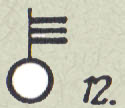 |
12th Regiment |
 |
8th Grenadier Battalion; 4th Bicycle Battalion; 2nd Independent Motorized Cross-country Battalion |
 |
6/2 Ranger Company; 2nd Motorcycle Company; 3/2 Motorized Company |
| Infantry Regiment Table of Organization & Equipment (TO&E) | |
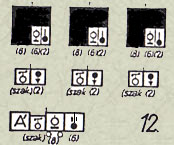 |
Row One: 12th Infantry TO&E by Battalions. Each Bn consists of three Companies with organic MGs and AT rifles. Row Two: Bn HQ Units: Signal (Szak.=Plt.) w/2 Radio sets. Tow Three: Regt HQ Units: Sapper and Signal & wagon-mounted MGs and infantry guns. |
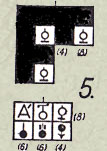 |
Row One: 5th Infantry Regt. TO&E. Row Two: Regt HQ Units: Line One: Sapper, Telephone; MG squads. Line Two: AT rifles; infantry guns; radio sets. |
| Infantry Battalion TO&E | |
 |
Row One; 8th Grenadier Bn and its organic MGs; Row Two: Bn HQ units: Sapper & Signal and radio sets & flame throwers. |
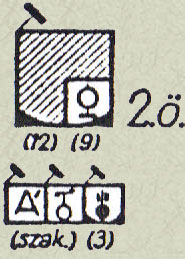 |
Row One; 2nd Independent Cross-country Motorized Bn of 12 & MGs. Row Two: Bn HQ units: Sapper & Telephone and Infantry Gun Section. |
| Infantry Company TO&E | |
 |
12th Regt/2nd Rifle Company; 4th Regt/3rd Bicycle Company; 2nd Motorized Company; 3rd Motorized Rifle Regt/2nd Company. |
| Symbols for a Company (Battery) and for a Platoon | |
 |
17th Independent Airborne |
 |
12th Sapper |
 |
8th Grenadier Telephone |
 |
5th Pack Animal MG Unit; 12th Wagon-mounted MG Unit; 6th Horse-drawn Ranger MG Unit. |
 |
18th Independent Heavy MG Unit |
 |
5th Antitank Rifle Unit |
 |
12th Infantry Gun Unit |
 |
15th Infantry Howitzer Unit |
 |
5th Mortar Unit |
 |
8th Flamethrower Unit |
 |
Squad and/or Patrol and/or Field Outpost of Infantry; Automatic Rifle; Bicycle; Motorcycle; Motorized. |
 |
Individual fighting man |
| Symbols for Marching Columns | |
 |
Infantry; Horse-drawn MG; Infantry; Mortar |
 |
Left Column: Bicyclist, Sapper, Telephone; Right Column: Motorcycle, MG |
| The 1st marching column of 3 blocks is a bicycle column, as
indicated by both the symbol and the kp. (kerékpár=bicycle) below. For the 2nd column of 2 blocks, mkp. (motorkerékpár=Motorcycle) below indicates a Motorcycle, not Bicycle Unit, although the symbol is a bicycle. | |
 |
Motorized Infantry: Infantry, Cross-country MG, Sapper, Infantry, Infantry Gun |
 |
Auto. Rifle, MG, Heavy MG, AT Rifle, Infantry Gun, Infantry Howitzer, Mortar, Flame Thrower: in firing position. Lower end of hairline indicatese the exact location of the firearm. |
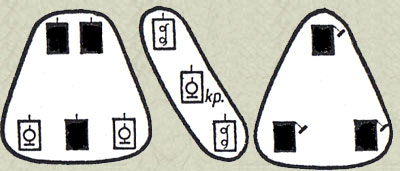 |
Spread-out units: Infantry, Bicycle, Motorized Infantry |
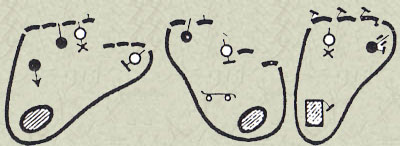 |
Units deployed for combat: Infantry, Bicycles, Motorized Infantry |
| Cavalry | |
 |
Generally same as infantry symbols, but with a diagonal slash. 7th Ind. Cavalry Sq., 3/4 Cavalry Troop, 3/II Cavalry AT Rifle Plat., 3rd Cavalry Telephone Company |
| Excceptions | |
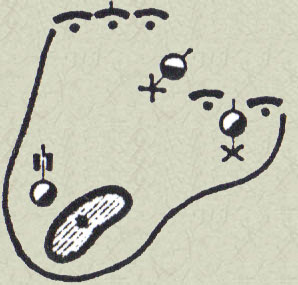 |
Cavalry formations fighting dismounted. Where we cannot apply the slash, use the abbreviationn for Cavalry, e.g.: "5 Cav." |